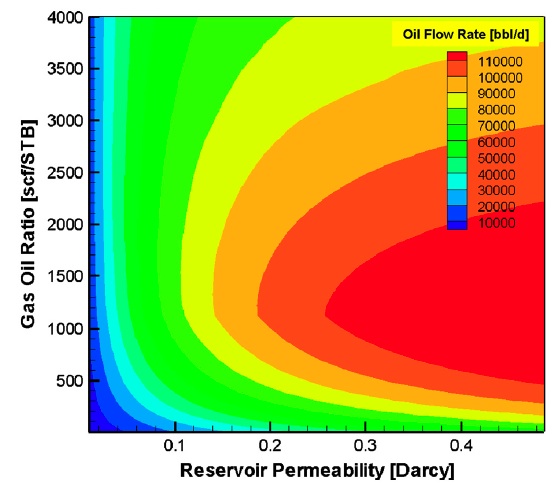The first two weeks of June 2010 were a blur for six scientists from the U.S. Department of Energy’s Lawrence Berkeley National Laboratory (Berkeley Lab). As the world focused on the ongoing crisis in the Gulf of Mexico after the blowout of BP’s Deepwater Horizon Macondo well, the scientists dropped everything to estimate how much oil was flowing from the mangled wellhead.

Among their findings, the Berkeley Lab team found that reservoir permeability had a strong influence on oil flow rate. This graphic tracks oil flow rate, in barrels per day, as a function of reservoir permeability and gas-oil ratio in a model in which the pressure at the blowout preventer is 4,400 pounds per square inch.
The clock was ticking: Their work would help assess the environmental impact of the disaster, as well as develop ways to cap the well, which had been spewing unchecked since April 20.
They used some of the world’s most sophisticated numerical modeling tools, developed at Berkeley Lab over the past two decades for applications ranging from geothermal energy production to environmental hydrology.
Working quickly and amid abundant uncertainties, they estimated that between 60,000 and 100,000 barrels of oil were flowing into the Gulf each day. Their calculations were in line with a final estimate derived two months later based on much more information.
Their research is recounted in an article published in this week’s online early edition of the Proceedings of the National Academy of Sciences.
“We were able to harness Berkeley Lab’s expertise in multiphase flow and computational tools to quickly take on this urgent problem,” says Curt Oldenburg, a staff scientist in Berkeley Lab’s Earth Sciences Division and lead author of the article. Also on the team were fellow Earth Sciences Division scientists Barry Freifeld, Karsten Pruess, Lehua Pan, Stefan Finsterle, and George Moridis.
The scientists were part of a group established by the National Incident Commander in May 2010 to estimate the oil flow rate from the wellhead. One component of this effort comprised scientists from five Department of Energy national laboratories, including Berkeley Lab.
The Berkeley Lab team first developed a simplified conceptual model of the system despite a lack of knowledge about the flow path from the reservoir into the well, reservoir permeability, and pressure in the blowout preventer. They then developed a coupled model of the reservoir and wellbore using a numerical program, called TOUGH2, which simulates fluid and heat flow in porous and fractured media.
Their simulations painted a range of flow rates, from a low of 60,000 barrels of oil per day to a high of 100,000 barrels of oil per day. Their initial estimates are in line with a final estimate established in August 2010 by the entire group and based on independent analyses and observations. It pegged the rate at 62,200 barrels of oil per day upon initial blowout in April, tapering to 52,700 barrels per day just before the well was capped in mid-July.
The Berkeley Lab team’s modeling approach also allowed them to determine the role played by various uncertainties. For example, they found that the rate of oil flow greatly increased as the length of the well in contact with the reservoir increases.
Surprisingly, they also determined that oil flow rate is relatively insensitive to the pressure at the bottom of the blowout preventer. Common sense dictates that as pressure drops at the bottom of the blowout preventer, the oil flow rate increases. Instead, the scientists found that the lower the pressure, the more natural gas exsolves from the oil. Natural gas interferes with oil flow and counteracts the pressure that drives oil upward in the well.
The work was supported by the Department of Energy’s National Energy Technology Laboratory and Assistant Secretary for Fossil Energy.
Lawrence Berkeley National Laboratory addresses the world’s most urgent scientific challenges by advancing sustainable energy, protecting human health, creating new materials, and revealing the origin and fate of the universe. Founded in 1931, Berkeley Lab’s scientific expertise has been recognized with 12 Nobel prizes. The University of California manages Berkeley Lab for the U.S. Department of Energy’s Office of Science. For more, visit www.lbl.gov.
Additional information:
- This research is described in an article entitled “Numerical simulations of the Macondo well blowout reveal strong control of oil flow by reservoir permeability and exsolution of gas,” that is published in the online early edition of the Proceedings of the National Academy of Sciences the week of July 4, 2011.